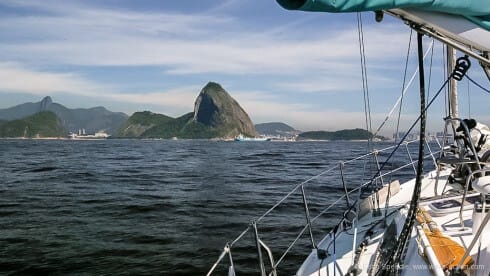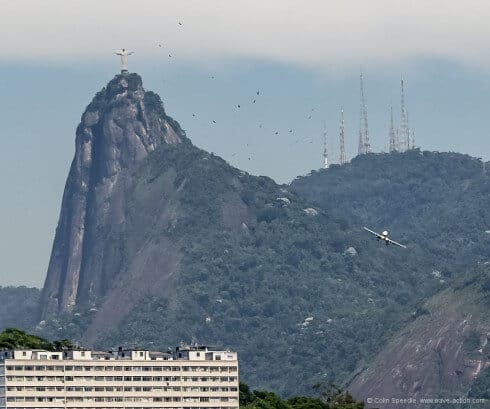
Land people sometimes ask what we cruisers do out there in the dark in the middle of the ocean. You don’t keep going all night, do you? Yes, we keep sailing. Don’t you just go to bed? No, we have to keep a watch out at all times. What for—surely there’s nothing out there? Well not a thousand miles from land there isn’t, it’s true. Just you, the stars and the parallel inner voyage that sometimes seems more vivid and enjoyable than the practical one that you’re living.
But inshore, that’s different—there’s little time for quiet reverie amidst all the shipping, fishing vessels, oil rigs, flashing buoys of indeterminate provenance and so on. No wonder it’s so tiring compared with ocean passage making. And Brazil has got it all, especially on the stretch that takes you from the Abrolhos to Vitoria and on to Rio de Janeiro.
The Phantom Fleet
Firstly there’s an active fishing fleet, working from the many shallow rivers and ports strung along the coast. For the greater part, these fishing vessels are relatively small (generally less than 30ft) and are constructed of wood. Most of them being painted in bright primary colours, they are relatively easy to spot by day, but at night it gets more complicated.
Sailing along in the dark with everything poled out and strapped down, a glance around the horizon will often reveal not a glimmer, until the moment you’re about to put your feet up when a single white light will appear. As the boat’s head swings and you try and get a fix on that light, so another one appears, then another, until it’s like fairyland out there and your peaceful watch is ruined.

Apparently, the local fishermen shut down their lights to avoid attracting flying fish, only turning them on when another vessel approaches. And radar is no help either, as wooden vessels of their size just don’t register on our small radar sets. Conducive to rest it isn’t, especially if the breeze is up as it tends to be on this stretch; the local sailors don’t call Vitoria ‘Ventoria’ for no reason. Even with our hull being pretty foul we were regularly clocking 9 knots with the help of the Brazil current on this leg.
Shipping and Natural Hazards
This is also a stretch with many large ports, handling and exporting the timber and mineral wealth of Brazil’s hinterland, such as Ubu, Tubarao and Vitoria itself. On the approaches to Vitoria we sailed through a fleet of well over 40 large VLCCs awaiting berths in Tubarao, and at all times we could see vessels arriving and departing via the dredged channel (which we had to cross) on our AIS—thank heavens for AIS!
Then you’re into oilrig country, with its attendant guard zones, tugs and supply vessels, before rounding the local Cape Horn—Cabo Frio—and making for Rio de Janeiro. Cabo Frio has a bad reputation, not only due to strong, shifting winds, but also because of the largest concentration of small inshore fishing boats along this whole stretch of the coast, so we weren’t looking forward to it.
Our original intention had been to duck in to the small harbour just inside the Cape for the night to avoid the worst of this madness, but a shatteringly loud firework display in the form of a thunderstorm convinced us otherwise. It also had the added benefit of persuading our fishing friends to stay in the bar, so we were able to round the headland in fine style.
All or Nothing
This last stretch of the coastline has the reputation as something of a windhole, and so it proved—we went from 25 knots over the stern to less than 5 knots in the space of a few miles, and so settled down to join the procession of shipping plugging along under power on their way to and from the great city, which finally rose out of the water at first light.

As I’ve mentioned before, Lou and I are emphatically not city people. But even the most jaded country lover couldn’t fail to be impressed by the spectacular entrance to Rio. Set amongst forest clad peaks that dwarf the skyscrapers of Ipanema and Copacabana (those songs!) the colossal figure of Christ the Redeemer gazes benignly down on the Sugarloaf and the puny efforts of man—an extraordinary and awe inspiring backdrop.

Entries to New Places are Always Nerve-Wracking

Which is only marred by the state of the water, no longer ocean blue but the colour (and texture?) of Brown Windsor Soup, scattered with croutons of rubbish, necessitating a ‘plastic watch’ all the way in to Marina Gloria in the heart of the city.
As we struggled to get someone, anyone, please, to answer our VHF requests for a berth, and fended off landing jets with the boathook, tempers were fraying, to say the least, especially after two action packed nights with virtually no sleep. Just as we were on the point of giving up, a voice broke through in perfect English, and a kind voice from the illustrious Iate Clube de Rio de Janeiro translated our request to the marina, fixed us up with a berth, and wished us “the warmest of welcomes to Rio de Janeiro”.
It’s an often overlooked (or underreported) fact of life in the world of long distance cruising that one of the toughest challenges we face is that of constantly coping with a different, difficult language and the massive cultural difference that exists from the world we know. At first it all seems wonderful and exotic, but after months out of your comfort zone, natural resilience can become overstretched and at times it can all seem just too much. But in a moment that can change, and whilst the lows can be lower, so the highs can be higher.
Thanks to that one simple, generous, intervention by a complete stranger as we sought rest and peace after a wearying journey, we suddenly became aware that the sun was out and that life was good. Sometimes it doesn’t take much to make your day.

Colin, Having done mostly coastal cruising these last few years, even multi-day passages, I can say that the only saving grace of coastal cruising is that you are likely to have a place to bail out to if things turn pear shaped. They are so very much more work than open ocean in just the ways you described.
My best, Dick
Hi Dick
Work it is, indeed. By comparison, ocean cruising is so relaxing, but you try explaining that to a tyro – they all think that it must be the other way around!
Best wishes
Colin
A big second on Brazilian fishing boats not showing up on radar. It was the worst in all our travels. If by chance you are using an old copy of the RCC Guide to Brazil that says you can clear out of Florinioplis, you can’t. Knowing what we know we would have checked out as soon as possible when (if you are) heading south, perhaps even Rio.
S.
Hi Scott
It never ceases to amaze me that fishing vessels seemingly don’t want to be seen, or are prepared to ignore the IRPCS lighting rules. But the I suppose that’s equally true of the yachties I’ve encountered who don’t believe in displaying lights at night in the open ocean….they obviously have more effective St Christopher’s than I do.
And on behalf of others passing this way, thanks for the tip on Florianopolis – Brazilian bureaucracy is certainly labyrinthine, isn’t it?
Best wishes
Colin
Well said. Funny how people think that crossing an ocean takes lots of courage and stamina…it’s a breeze compared with sailing the Portuguese Atlantic coast where anything and everything can happen if you’re not ready for the battle.
Hi Horatio
Amen to that – the Portuguese Atlantic coast is the worst for fishing effort and fixed gear I’ve ever encountered. If it weren’t for the fact that so many of the smaller ports are so nice, I’d be tempted to stay at least 50 miles off the coast and be done with it. But – Portugal is so lovely, and so welcoming away from the big towns, well it would be a tragedy to miss out on that.
Best wishes
Colin
Of the silly questions we get asked about ocean crossings, my favourite is always,” Do you anchor at night?” Why sure we do, carrying 25 000 m of chain and warp ( say 5 times scope for a 5000m depth) is no problem.!
Hi Kevin
perhaps equalled by the simple ‘what do you do out there?’ As if you just switch off, and not:
Stand your watch
Fix the boat
Make endless decisions
Carry out essential maintenance etc.etc, etc!
Would that it were so simple………
Best wishes
Colin
Love love love the picture of the Brazilian fishermen… especially the one at home and waving on the starboard quarter..
It is what I think it is isn’t it?
That looks like a push boat for the nets snugged to the stern of the Brazilian fishing boat…..or is it something else. I hope it’s ok to use this picture on my desktop. Such great tales brings us right along with you. Thanks!
Ray
I have a question not related to the subject of this posting, but related to the first photo in the posting.
The first photo shows a Wichard Gyb’Easy Boom Brake in use. Last year we purchased one and used it all season on our Cape Dory 36. All in all we are happy with it. However, we found that when mounted as recommended (and shown in the above photo) the provided line is not long enough to reach back to the cockpit on Both sides. We are wondering how the owners of the boat in the above photo dealt with this issue??? We have attempted to contact Wichard via the internet without success to see if it was possible to obtain longer line. We have also been unable to find the line available in other lengths on the internet. This year we are going to attempt to substitue some longer Sta-Set line and see how it works. We will report our results if anyone is interested.
Hi Philip and Sharon
We had the same problem -the line was too short, so we went back to Wichard and they supplied us with a longer line (to our spec), and we returned the original – the cost difference wasn’t huge.
I’d suggest you continue to chase them, and let them know that this dialogue is going on!
Best wishes
Colin
Will do. Thanks Colin for your response.
Philip & Sharon
This is the response that we got. Sadly, I really did not expect better. Never did get a response from the UK branch.
————————————————————————————
Hi,
Thank you for your online inquiry.
We recommend to run only one end of the line back to the cockpit. So we normally dead end the rope on one side, directly on the chainplate or another strong fixing point in the same location. From there, you run the line
through the Gyb’Easy and then you use a turning block on the opposite side to bring the line back. This way you would have enough line.
Unfortunately, Wichard does not supply longer Gyb’ Easy lines, but if you still wish to run both ends back, then you could buy a Dynamic climbing rope that has enough stretch.
Please let us know if you need any further information.
Regards,
Damien De Pas
Wichard Inc.
148a Bryce Blvd
Fairfax, VT 05454 USA
Tel: (401) 683-5055, ext. 223
Fax: (802) 655-4689 – Vermont
E-mail: